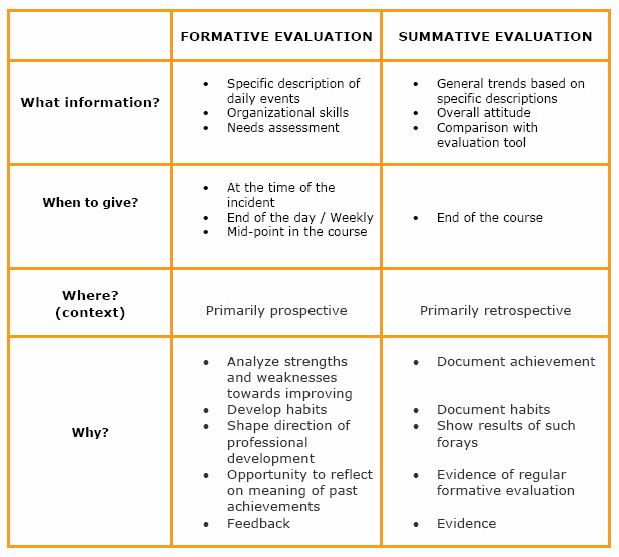Difference between revisions of "Formative Evaluation"
From Learning and training wiki
Chantal joly (Talk | contribs) (New page: {{Term|FORMATIVE EVALUATION|Gathering of information about learner knowledge acquisition during the progression of a course or program. It enables the trainer to ...) |
Chantal joly (Talk | contribs) |
||
| Line 1: | Line 1: | ||
| − | {{Term|FORMATIVE EVALUATION|Gathering of information about learner [[Knowledge Acquisition|knowledge acquisition]] during the progression of a course or program. It enables the trainer to determine the degree to which learners know or are able to do a given learning task, and to identify which part of the task learners don’t know or are unable to do. The [[Outcomes]] suggest future steps for teaching and learning. This [[assessment]] encompasses trainer observation, classroom discussion and analysis of learner’s work, including homework and tests. Assessments become formative when the information is used to adapt teaching and learning to meet learner’s needs. Formative assessment helps learners become aware of any gap that exists between their desired goal and their current [[knowledge]], understanding, or skills, and guides them through actions necessary to obtain the goal. <ref>[http://www.aacu.org www.aacu.org] (14 March 2008), [http://internettime.com internettime.com] (14 March 2008), [http://pareonline.net pareonline.net] (14 March 2008)</ref> The conduction of a formative evaluation requires the identification of specific characteristics related to the kind of information provided, the | + | {{Term|FORMATIVE EVALUATION|Gathering of information about learner [[Knowledge Acquisition|knowledge acquisition]] during the progression of a course or program. It enables the trainer to determine the degree to which learners know or are able to do a given learning task, and to identify which part of the task learners don’t know or are unable to do. The [[Outcomes]] suggest future steps for teaching and learning. This [[assessment]] encompasses trainer observation, classroom discussion and analysis of learner’s work, including homework and tests. Assessments become formative when the information is used to adapt teaching and learning to meet learner’s needs. Formative assessment helps learners become aware of any gap that exists between their desired goal and their current [[knowledge]], understanding, or skills, and guides them through actions necessary to obtain the goal. <ref>[http://www.aacu.org www.aacu.org] (14 March 2008), [http://internettime.com internettime.com] (14 March 2008), [http://pareonline.net pareonline.net] (14 March 2008)</ref> The conduction of a formative evaluation requires the identification of specific characteristics related to the kind of information provided, the timing and the aim - the what, where and why one can find in the [[#Formative versus Summative Evaluation|Formative versus Summative Evaluation table]]. Ideally, the two modes are complementary. Also, as noted in the table below, the process of formative evaluation may be an important component in summative evaluation. See also: [[Evaluation]], [[Summative Evaluation]]. |
=='''Formative versus Summative Evaluation'''== | =='''Formative versus Summative Evaluation'''== | ||
Revision as of 15:24, 19 November 2008
Gathering of information about learner knowledge acquisition during the progression of a course or program. It enables the trainer to determine the degree to which learners know or are able to do a given learning task, and to identify which part of the task learners don’t know or are unable to do. The Outcomes suggest future steps for teaching and learning. This assessment encompasses trainer observation, classroom discussion and analysis of learner’s work, including homework and tests. Assessments become formative when the information is used to adapt teaching and learning to meet learner’s needs. Formative assessment helps learners become aware of any gap that exists between their desired goal and their current knowledge, understanding, or skills, and guides them through actions necessary to obtain the goal. [1] The conduction of a formative evaluation requires the identification of specific characteristics related to the kind of information provided, the timing and the aim - the what, where and why one can find in the Formative versus Summative Evaluation table. Ideally, the two modes are complementary. Also, as noted in the table below, the process of formative evaluation may be an important component in summative evaluation. See also: Evaluation, Summative Evaluation.
Formative versus Summative Evaluation
|
| Below you have a list of selected websites where you can findadditional information: |
| Link | Content |
|---|---|
| www.courses.psu.edu | Powerpoint presentation on designing and conducting a Formative Evaluation. |
| www.learningandteaching.dal.ca | Different methods of formative evaluation, including evaluation for your own teaching and distribution of short questionnaries to learners. |
References
- ↑ www.aacu.org (14 March 2008), internettime.com (14 March 2008), pareonline.net (14 March 2008)
